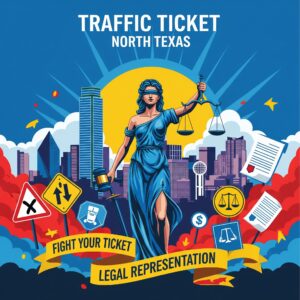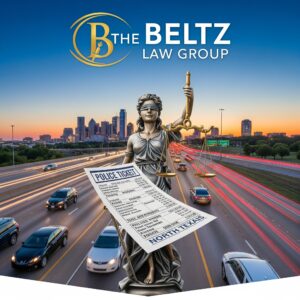Last Updated on July 23, 2025 by Beltz Law Group
Facing a “Failure to Make Proper Turn” Ticket in Texas? What You Need to Know

Traffic Ticket Defense Texas
Receiving a traffic ticket for “failing to make a proper turn at an intersection” is a common occurrence on Texas roads. While it might seem like a minor infraction, these citations are considered moving violations and can have significant consequences for your driving record, insurance rates, and overall financial well-being.
At Beltz Law Group, we frequently help clients navigate these types of tickets. This article will explain the relevant laws, the potential impact of such a ticket, and why seeking legal advice is often your best course of action.
If you’ve been cited for an improper turn and would like to discuss your options with an experienced attorney, please contact our office at your earliest convenience at 214-321-4105.
Is It a Moving Violation? Yes, and Here’s Why That Matters
Any violation for failing to properly turn at an intersection in Texas is classified as a moving violation. This is a critical distinction because moving violations are reported to the Texas Department of Public Safety (DPS) and can:
- Impact Your Driving Record: Points accumulate on your driving record for moving violations. Too many points can lead to surcharges from the state, which are additional fees you pay annually on top of your fine.
- Increase Your Insurance Rates: Insurance companies often review your driving record. A moving violation can signal increased risk, potentially causing your auto insurance premiums to rise significantly.
- Lead to Driver’s License Suspension: Accumulating too many points or certain types of moving violations can ultimately lead to the suspension of your driver’s license, making it illegal for you to drive.
For these reasons, it’s generally not advisable to simply pay a traffic ticket for an improper turn. Paying the ticket typically means pleading “guilty” or “no contest,” resulting in a conviction that goes on your record.
Instead, the recommended first step is to plead “not guilty.” Once you’ve entered a not guilty plea, the court will usually schedule your case for a pretrial hearing. This hearing provides an opportunity to discuss the matter with a prosecutor or the court. During this discussion, various outcomes are possible: your case could be dismissed, you might be offered a deferred disposition (probationary period), or if no agreement can be reached, the case could be set for trial.

North Texas Traffic Ticket Defense Attorney
The Law Governing Turns at Intersections
The rules for making turns at intersections in Texas are specifically detailed in the Texas Transportation Code, Section 545.101. TURNING AT INTERSECTION. Understanding this statute is key to evaluating whether a violation actually occurred and how to defend your case.
Here’s a breakdown of the law:
- Sec. 545.101. TURNING AT INTERSECTION.
- (a) Right Turns: “To make a right turn at an intersection, an operator shall make both the approach and the turn as closely as practicable to the right-hand curb or edge of the roadway.”
- What this means: When turning right, you must position your vehicle as close as safely possible to the right side of your lane as you approach the intersection and maintain that proximity throughout the turn. This prevents “wide right turns” or cutting across lanes.
- (b) Left Turns (General Rule): “To make a left turn at an intersection, an operator shall:
- (1) approach the intersection in the extreme left-hand lane lawfully available to a vehicle moving in the direction of the vehicle; and
- (2) after entering the intersection, turn left, leaving the intersection so as to arrive in a lane lawfully available to traffic moving in the direction of the vehicle on the roadway being entered.”
- What this means: You should enter the intersection from the leftmost lane designated for your direction of travel. Once in the intersection, you should turn into a lane that legally accommodates traffic moving in your new direction (e.g., the leftmost lane on the new road, unless signs or markings indicate otherwise). This prevents turns that are too wide or cutting off oncoming traffic.
-

Traffic Ticket Defense Attorney
(c) Left Turns on Two-Way Streets: “On a street or roadway designated for two-way traffic, the operator turning left shall, to the extent practicable, turn in the portion of the intersection to the left of the center of the intersection.”
- What this means: When making a left turn from a two-way street onto another two-way street, you should make your turn in such a way that you are to the left of the center point of the intersection as you execute the turn. This helps ensure you stay on the correct side of the road and don’t impede opposing traffic.
- (d) Left Turns from One-Way Streets (Signed): “To turn left, an operator who is approaching an intersection having a roadway designated for one-way traffic and for which signs are posted from a roadway designated for one-way traffic and for which signs are posted shall make the turn as closely as practicable to the left-hand curb or edge of the roadway.”
- What this means: When turning left from a one-way street onto another one-way street, you should approach and complete the turn as close as possible to the left curb or edge of both roadways.
- (e) Exceptions by Authority: “The Texas Transportation Commission or a local authority, with respect to a highway in its jurisdiction, may:
- (1) authorize the placement of an official traffic-control device in or adjacent to an intersection; and
- (2) require a course different from that specified in this section for movement by vehicles turning at an intersection.”
- What this means: This is an important clause. It allows TxDOT or local authorities (like city or county governments) to install signs or markings at an intersection that override the general turning rules outlined in Subsections (a) through (d). For example, a sign might direct a right turn from a lane that isn’t the far right, or a left turn from a specific lane other than the extreme left. If such a device is present and properly placed, you must follow it, even if it differs from the general rule.
- (a) Right Turns: “To make a right turn at an intersection, an operator shall make both the approach and the turn as closely as practicable to the right-hand curb or edge of the roadway.”
Building Your Defense: What an Attorney Can Do

North Texas Ticket Defense Lawyer
Successfully defending an improper turn ticket often involves more than simply stating you didn’t do it. An experienced traffic ticket attorney can:
- Analyze the Specific Law: We’ll examine the exact wording of the citation and the corresponding section of the Transportation Code to identify any discrepancies or potential defenses.
- Investigate the Intersection: We can assess the intersection where the alleged violation occurred. Were there clear lane markings? Were signs properly placed and visible? Was there any unusual road construction or obstruction that contributed to the incident?
- Review Officer’s Observations: We’ll discuss the officer’s perspective and look for inconsistencies in their account. Did they have a clear view? Was their judgment potentially impacted by other factors?
- Negotiate with the Prosecutor: Our goal is to achieve an outcome that protects your driving record. This might involve seeking a dismissal, a deferred disposition (where the ticket is dismissed if you complete a probationary period without further violations), or a reduction to a non-moving violation if appropriate.
- Represent You in Court: If the case proceeds to trial, we will represent you, present evidence, cross-examine the officer, and argue your case effectively to the judge.
Don’t let a “failure to make a proper turn” ticket negatively impact your driving record and financial future without exploring your options. The complexities of traffic law, combined with the potential for rising insurance rates and state surcharges, make legal representation a wise investment.
Contact Beltz Law Group today at 214-321-4105 for a free consultation. Our skilled attorneys are ready to help you navigate your traffic ticket and protect your record.







